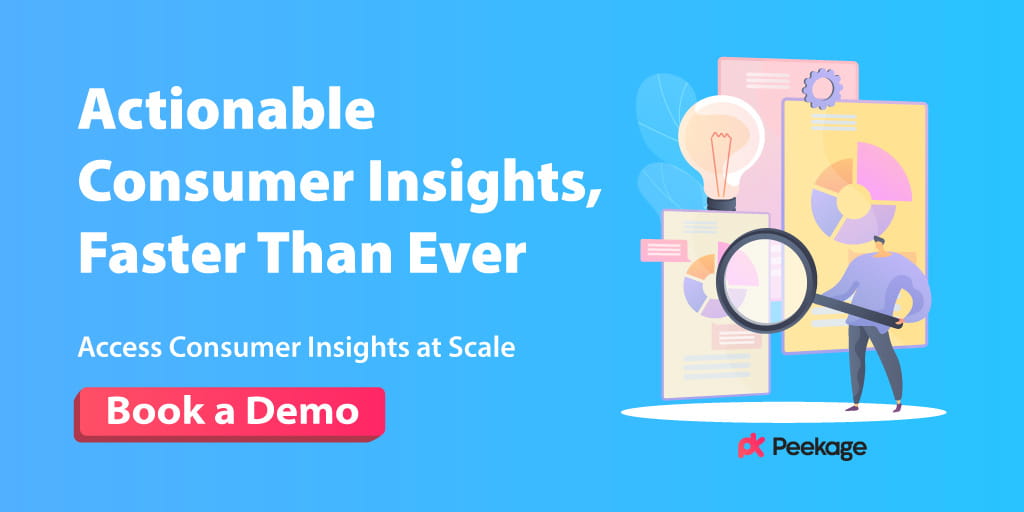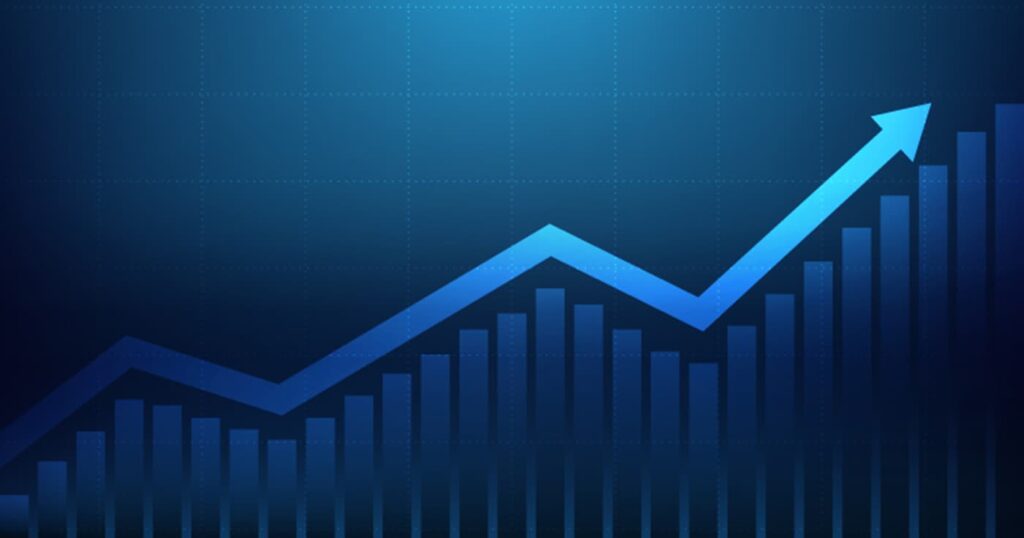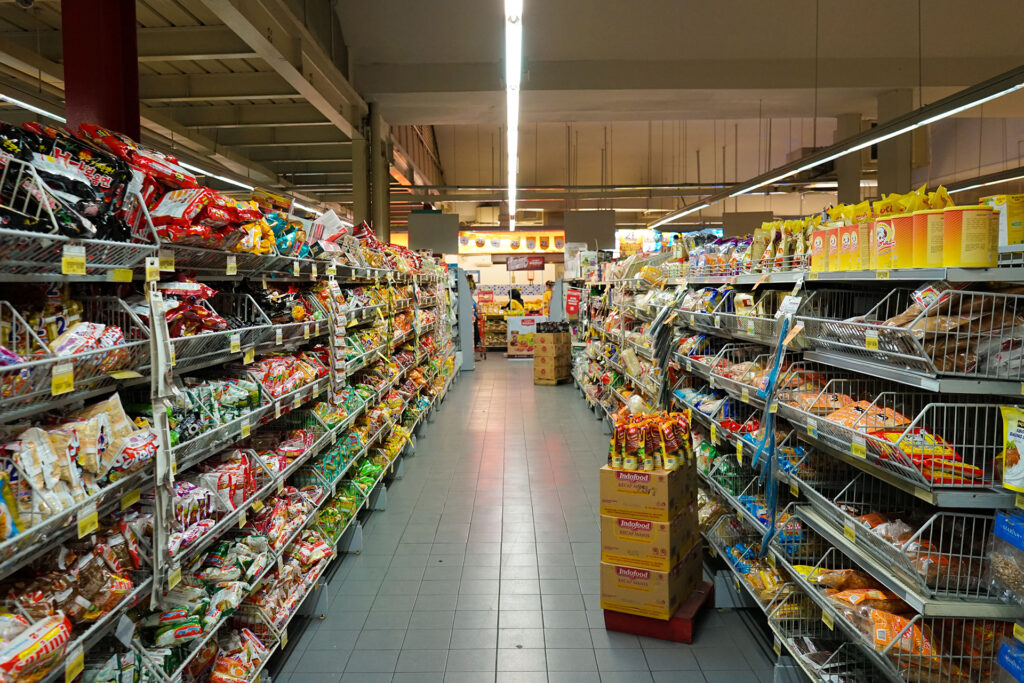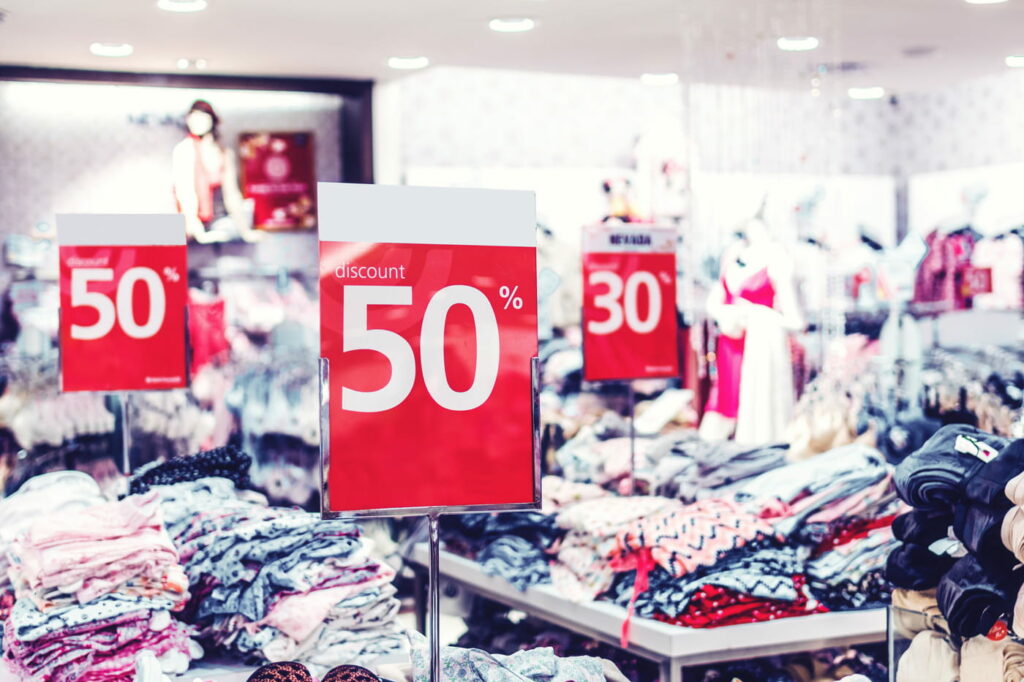As a product manager for a consumer brand, dealing with inventory issues due to inaccurate demand forecasting can be frustrating. Stockouts and overstocks are both costly, leading to lost sales, disappointed customers, and excess carrying costs.
Demand forecasting is both an art and a science. Do it well and you can optimize production, reduce waste, and maximize profits. Mess it up and you'll be swimming in unsold merchandise or turning customers away empty-handed. All in all, effective demand forecasting is crucial for CPG brands (Consumer Packaged Goods) to avoid costly surprises, optimize inventory levels, and drive growth.
But what is demand forecasting exactly? And how can consumer brands like yours nail it? This guide has you covered.
Peekage solutions: Consumer insights services
What is Demand Forecasting?
Demand forecasting is the process of estimating and predicting consumer demand for a product or service over a future time period. It allows companies to make better inventory management, production, and marketing decisions.
For example, if a company sold 100 units of a product in January, 120 units in February, and 150 units in March, we can forecast demand for around 170 units in April, assuming market conditions remain the same.
The key points are:
- Use past sales data (100, 120, 150 units)
- Observe the trend (sales increasing month-over-month)
- Forecast next month's demand by extrapolating the trend (forecasting 170 units for April)
- Assuming no major changes in market conditions
So by analyzing recent historical sales and projecting the pattern forward, businesses can make an informed forecast about upcoming demand for their products.
Accurate demand forecasts are essential for matching supply with demand as closely as possible. They help businesses avoid expensive shortage costs from underproducing or carrying costs from overproducing. Studies show that accurate forecasts can lead to a reduction in inventory costs by 20% to 50%.

Peekage solutions: Product sampling agency
Demand Forecasting Important for Consumer Brands
Demand forecasting isn't just about predicting sales numbers; it's about anticipating consumer behavior, optimizing inventory management, and ultimately maximizing profitability. With accurate forecasts, brands can:
1. Optimize Inventory Levels:
Your forecast determines how much product you need to manufacture and stock. Too little and you risk stockouts and lost sales. Too much and you're stuck paying storage costs and potentially having to discount excess inventory.
2. Streamline Production Scheduling: Demand forecasts guide production schedules and raw material purchasing, preventing rush orders or excess capacity.
3. Enhance Financial Planning: Forecasts feed into budgeting, cash flow projections, revenue and profit estimates, capacity planning, and other financial plans.
4. Align Marketing Efforts: Accurate demand signals help decide the appropriate marketing investment needed to achieve sales goals.
Precise demand forecasting enables consumer brands to minimize costs, reduce waste, ensure smoother operations, and boost customer satisfaction through better product availability. It's a critical component for success in the consumer goods industry.
Demand Forecasting Challenges Consumer Brands Face
While demand forecasting is crucial, it's no easy task for CPG brands due to factors like:
- Short product lifecycles - In fast-moving consumer categories, products come and go quickly making historical data less reliable.
- Market volatility - Unexpected economic jolts like recessions, supply chain disruptions, or viral social media trends can dramatically shift consumer demand patterns. For instance, during the COVID-19 pandemic, supply chain disruptions caused a significant shift in consumer behavior, leading to changes in purchasing habits and preferences.
- Data quality issues - Bad input data from faulty POS systems, inaccurate syndicated sources, or siloed internal records lead to forecast errors.
- Human judgment - Forecasts often involve managerial overrides based on experience and market intelligence, but human biases and errors can taint projections if unchecked.
- Complex demand patterns - Factors like seasonality, promotions, competitive moves, pricing changes, and evolving consumer preferences combine to create volatile, difficult-to-predict demand signals.
Here's a table outlining various factors that can impact the demand forecasting process:
| Factor | Description |
| Historical Sales Data | Past sales data serves as a crucial foundation for forecasting future demand patterns. Analyzing trends and seasonality helps in making accurate predictions. |
| Market Trends | External factors such as economic conditions, consumer preferences, technological advancements, and competitive landscape influence demand forecasts. |
| Seasonality | Demand often fluctuates based on seasonal variations, such as holidays, weather patterns, or cultural events. Recognizing these patterns is essential. |
| Marketing and Promotion Activities | Marketing campaigns, discounts, promotions, and advertising efforts can significantly impact consumer behavior and influence demand forecasts. |
| Pricing Strategies | Changes in pricing strategies, including discounts, sales, or price increases, can directly affect consumer demand and need to be factored into forecasts. |
| Product Lifecycle | Different stages of a product's lifecycle, such as introduction, growth, maturity, and decline, have varying demand patterns that should be considered. |
| Inventory Levels | The availability of inventory and its management affect demand forecasts. Stockouts or excess inventory can distort demand predictions. |
| Supplier Performance | Issues with suppliers, such as delays, quality problems, or disruptions in the supply chain, can impact the availability of products and subsequently, demand. |
| Economic Factors | Economic indicators like inflation rates, GDP growth, unemployment rates, and consumer confidence levels influence purchasing power and demand for goods. |
| Regulatory Changes | Changes in regulations, such as tariffs, trade policies, or industry-specific regulations, can alter market dynamics and affect demand forecasts. |
Overcoming these multifaceted obstacles through robust data integration, advanced forecasting techniques and continuous process refinement is critical for CPG brands to optimize production planning, inventory management, and marketing ROI.
The Demand Forecasting Process
While there's no one-size-fits-all process, an effective demand forecasting process typically involves several key steps:
1. Gather and Prepare Data
Your forecast is only as good as the data behind it. So, the first step is gathering relevant data from various sources. This includes
- Historical shipments - Sell-through data from retailers, distributors, ecommerce, etc.
- Marketing activity - Pricing, promotions, advertising, and other demand-influencing activities.
- Market intelligence - Analyst reports, POS and syndicated data, economic indicators, and more.
You'll need to integrate, cleanse, and organize this data from multiple sources into a standardized format for analysis.
2. Analyze Demand Patterns and Drivers
Once the data is collected, it undergoes thorough analysis to identify patterns, trends, and correlations.
- Seasonality and cyclical fluctuations
- Pricing and promotional effects
- Product lifecycles and cannibalization impacts
- Economic factors like employment, inflation, etc.
- Competitor activities and market events
This exploratory analysis reveals which factors and variables you'll need to account for in your forecast.
A Deloitte study found companies with accurate forecasts achieve 7+ percentage points higher profits.
3. Select Forecasting Method(s)
There are various quantitative forecasting techniques to choose from based on your data, resources, and required accuracy. Common methods include:
- Time series models like exponential smoothing
- Causal/ regression models incorporating demand drivers
- Machine learning techniques like neural nets
It’s also good to consider qualitative methods as well. These techniques rely on expert judgment, market surveys, and consumer feedback to forecast demand. While less precise, qualitative methods are valuable for capturing subjective factors influencing consumer behavior.
Many brands combine multiple methods through ensemble forecasting to improve accuracy. You might use one model for baseline forecasts and others to estimate promotional lifts.
4. Generate Forecasts
Once the model is developed and validated, it is used to generate forecasts for future demand. These forecasts may be short-term, medium-term, or long-term, depending on the planning horizon and business requirements.
You can generate baseline forecasts by SKU, geography, channel, customer, etc. Most brands’ forecasts are at least:
- Annual forecast to align with financial plans.
- Monthly forecasts for management reporting.
- Weekly forecasts for inventory and production planning.
These forecasts are just the starting point and need to be further adjusted and validated.
5. Review, Reconcile and Finalize
Demand forecasting is an iterative process, and regular review and adjustments are essential. As new data becomes available and market conditions change, forecasts may need to be revised accordingly. Key activities include:
- Add overrides and tweaks based on market conditions, new product launches, promotions, and management judgment.
- Align with financial targets and reconcile top-down and bottom-up forecasts.
- Validate with sales and product teams to get input and buy-in.
- Finalize and approve forecast for operational use.
Continuous monitoring of forecast accuracy helps identify any deviations and refine the forecasting models.
6. Monitor, Learn and Re-Forecast
Even with the most sophisticated process, your forecast will be wrong to some degree. Brands must continually monitor forecast accuracy by comparing projections to actual sales/ shipments.
This "wake/ sleep" process of monitoring forecast errors, identifying root causes, and feeding learnings back into future forecasts is crucial. It allows you to refine and improve your technique over time through better:
- Demand modeling and driver variables
- Forecasting method and parameter selection
- Human judgment and overrides
The more you forecast and check results, the smarter your demand forecasting process becomes.
7. Integrating with Business Planning:
The final step involves integrating the demand forecasts into the overall business planning process. Forecasts are used to make informed decisions regarding production scheduling, inventory management, procurement, marketing strategies, and resource allocation.
The Demand Forecasting Tech Stack
In order to achieve effective demand forecasting on a large scale, a robust technology infrastructure is essential. Leading consumer brands rely on specialized solutions such as:
- Data Integration Tools: Tools like Alteryx and Informatica are utilized to amalgamate diverse data sources into unified demand datasets.
- Statistical Forecasting Engines: Solutions such as SAS, Oracle, and Forecast Pro employ automated modeling techniques including time series, regression, and machine learning.
- Planning and S&OP Platforms: Platforms like Kinaxis and ToolsGroup help in operationalizing forecasts into production, inventory, and financial plans.
- BI and Analytics Software: Software like Tableau and Power BI are employed for forecast reporting, dashboards, and value-added analytics.
- Custom Solutions: Companies like Peekage offer real-time consumer testing platforms that provide invaluable demand insights, offering features like:
- Real-Time Data Utilization: Integrate up-to-the-minute consumer feedback and trends to dynamically adjust forecasts.
- Segment Analysis: Analyze feedback based on demographics, locations, and purchase behaviors to tailor forecasts for different market segments.
- Continuous Refinement: Continuously enhance forecasting models based on real-world performance, iterating towards greater precision over time.
While some brands opt for building custom forecasting capabilities, the best-of-breed solutions offer robust, pre-built functionality. The key is an integrated tech stack generating accurate, granular forecasts embedded into operational plans. Industry reports estimate companies spend 20% of supply chain budgets on demand planning solutions.
Advanced Demand Forecasting Techniques
To achieve more accurate predictions, brands leverage advanced analytical techniques like:
- Machine Learning: Machine learning algorithms, such as neural networks and decision trees, can analyze large datasets and identify complex patterns beyond the scope of traditional statistical methods. By training models on historical data and adjusting parameters iteratively, brands can develop highly accurate forecasts.
- Predictive Analytics: Predictive analytics integrates historical data, real-time consumer insights, and external variables to generate forward-looking forecasts. By incorporating factors like economic indicators, social media trends, and weather patterns, brands can anticipate demand fluctuations with greater precision.
- Collaborative Forecasting: Collaborative forecasting involves engaging key stakeholders, including sales teams, marketing experts, and supply chain managers, in the forecasting process. By leveraging collective expertise and diverse perspectives, brands can generate more accurate forecasts and align strategies across departments.
Demand Forecasting Best Practices
Based on our experience and talking to other demand planners, here are some best practices for consumer brands:
- Leverage All Relevant Data Sources: Historical sales, marketing activities, market research, economic data, and more to fully capture demand drivers.
- Blend Quantitative Models with Human Insights: Combination of statistical forecasts with market intelligence through a structured judgmental forecasting process.
- Forecast at Granular Levels: Project demand at the most granular level (SKU/ location/ customer) before aggregating up as needed.
- Deploy Value-Added Analytics: Scenario planning, constrained forecasts, and safety stock calculations to optimize operations.
- Enable Cross-Functional Alignment: Integrate demand forecasts into sales & operations planning (S&OP) workflows.
- Invest in Forecasting Capabilities: Technology, talent, and continuous improvement to support advanced forecasting techniques and accuracy.
Conclusion
Effective demand forecasting is essential for consumer brands in today's volatile, competitive markets. While it's a complex, data-driven process, getting it right pays huge dividends through:
- Decreased inventory carrying costs
- Reduced waste and obsolescence
- Improved production efficiency
- Better capacity and financial planning
- Higher service levels and customer satisfaction
It's not easy but with the right approach, process, and tools - your forecast. Remember, accurate forecasts aren't just about predicting the future—they're about shaping it. So, dive in, experiment, and let data be your guide to success!
FAQs
1. What are the 5 methods of demand forecasting?
Here are the most common methods:
- Market Research
- Time Series Analysis
- Delphi Method
- Expert Opinion
- Regression Analysis
2. What are the steps in demand forecasting?
Demand forecasting typically involves several key steps. First, it's essential to gather historical sales data to understand past trends. Next, identify any external factors that may influence demand, such as economic conditions or changes in consumer preferences. Then, select an appropriate forecasting method, whether qualitative or quantitative, depending on the available data and the nature of the product or service. After that, apply the chosen method to generate a forecast. Finally, regularly review and refine the forecast based on new information and updates to ensure its accuracy and relevance.
3. How do you calculate demand forecast?
Demand forecasts are typically calculated using statistical models, historical data analysis, market research, and input from experts in the field.
4. What is the most common method of forecasting demand?
The most common method of forecasting demand is through time series analysis, which involves examining historical data to identify patterns and trends that can be used to predict future demand.
5. What are the key KPIs for demand forecasting?
Key Performance Indicators (KPIs) for demand forecasting typically include metrics such as forecast accuracy, mean absolute percentage error (MAPE), bias, inventory turnover, and service level attainment.
References
- Inventory Optimization Guide, Ship Bob,
https://www.shipbob.com/inventory-management/inventory-optimization/ - 5 Ways to Improve Inventory Management, Red Stag Fulfillment,
https://redstagfulfillment.com/5-ways-improve-inventory-management/ - What is supply chain?, Mckinsey,
https://www.mckinsey.com/featured-insights/mckinsey-explainers/what-is-supply-chain - Data Integration Tools Reviews and Ratings, Gartner,
https://www.gartner.com/reviews/market/data-integration-tools - How To Apply Machine Learning To Demand Forecasting in Retail, Mobidev,
https://mobidev.biz/blog/retail-demand-forecasting-with-machine-learning - Predictive big data analytics for supply chain demand forecasting, Journal of Big Data,
https://journalofbigdata.springeropen.com/articles/10.1186/s40537-020-00329-2




